

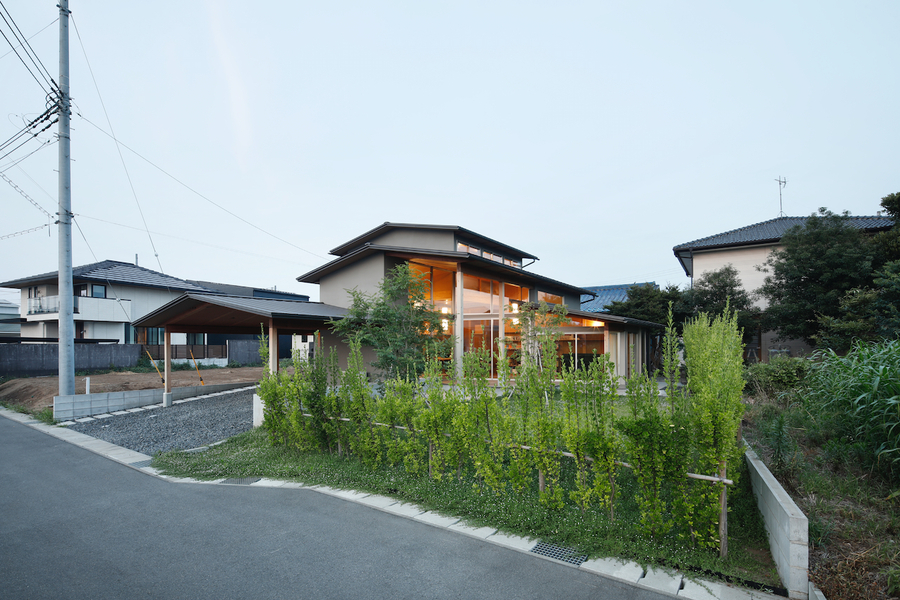
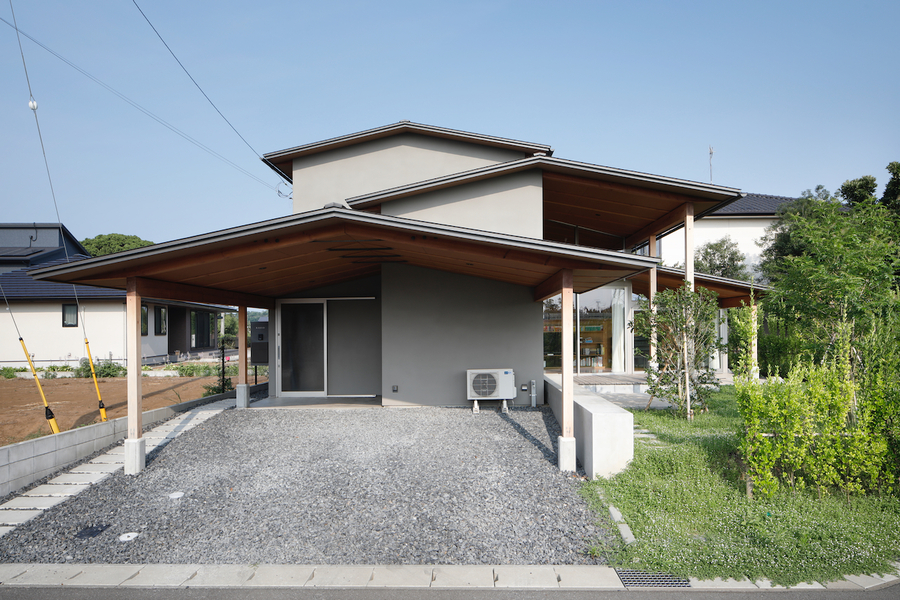

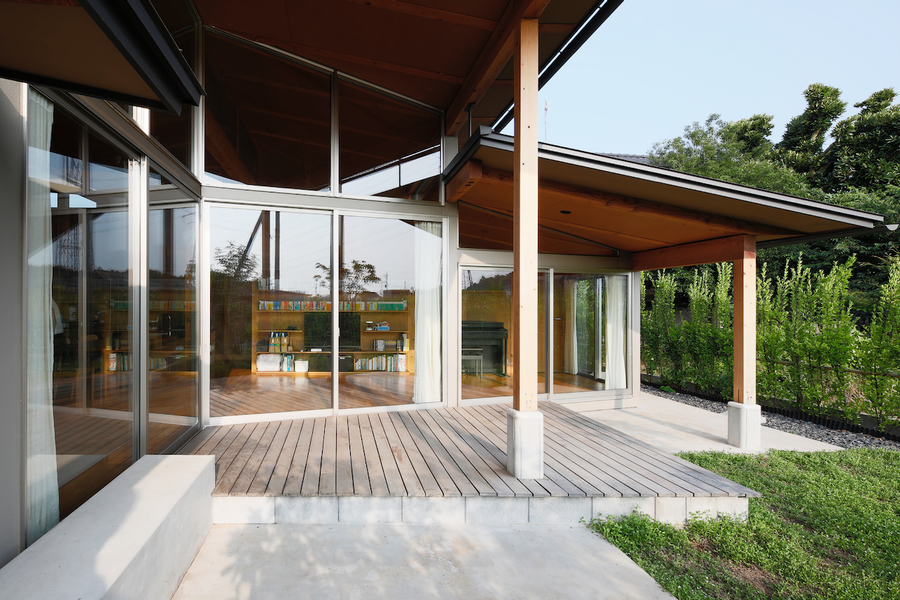
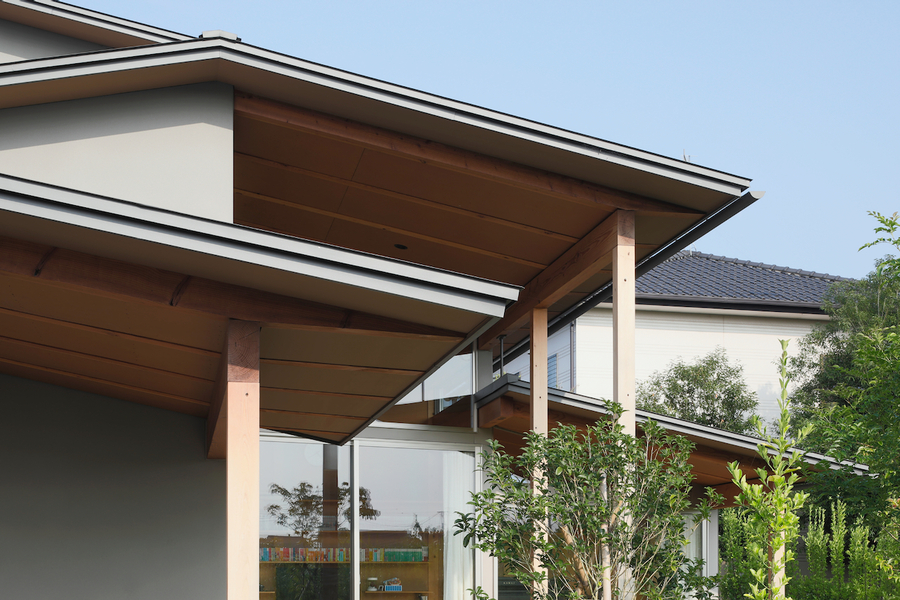
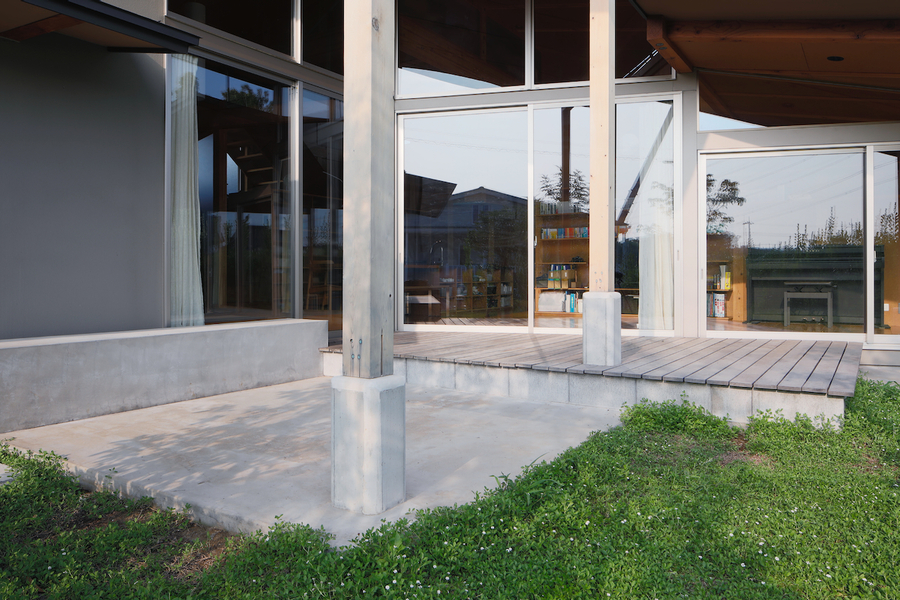
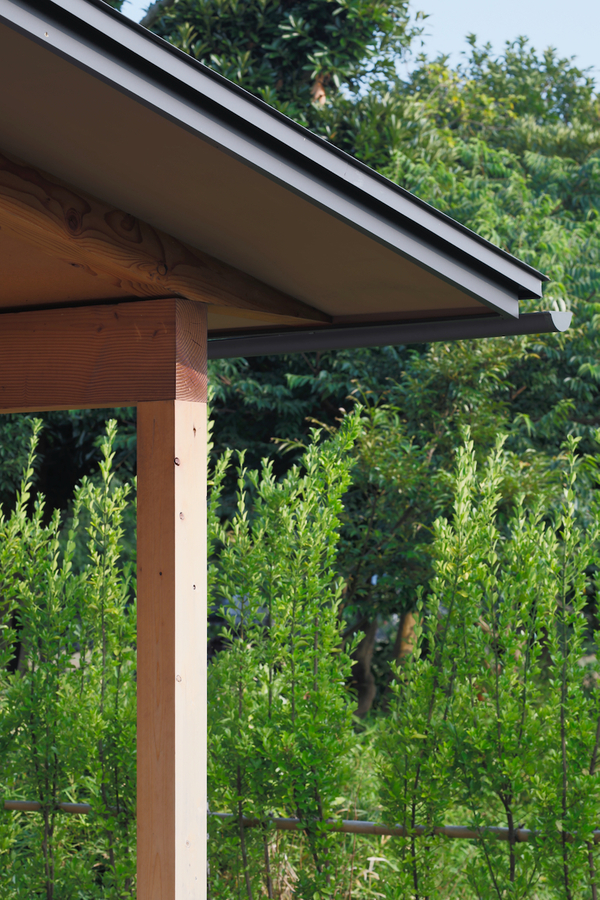
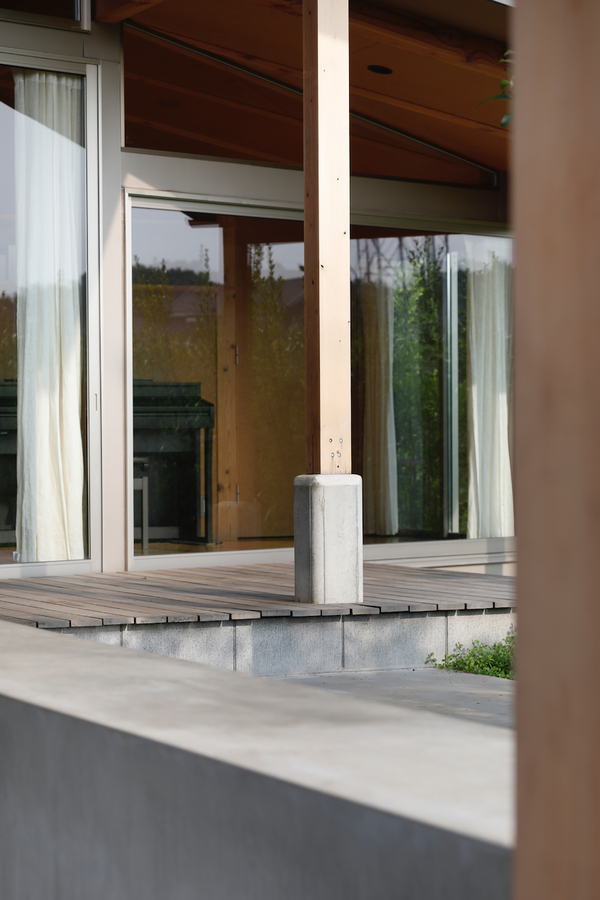
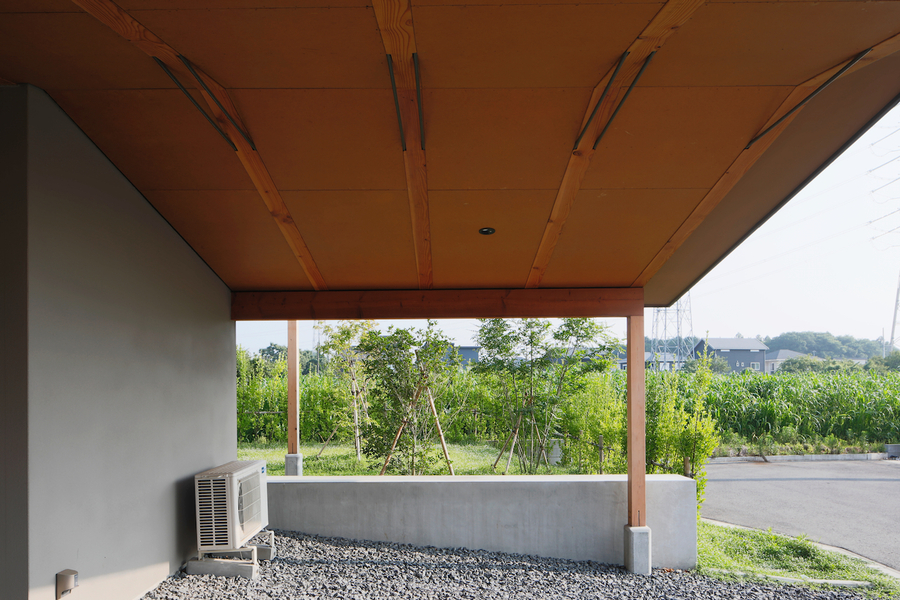
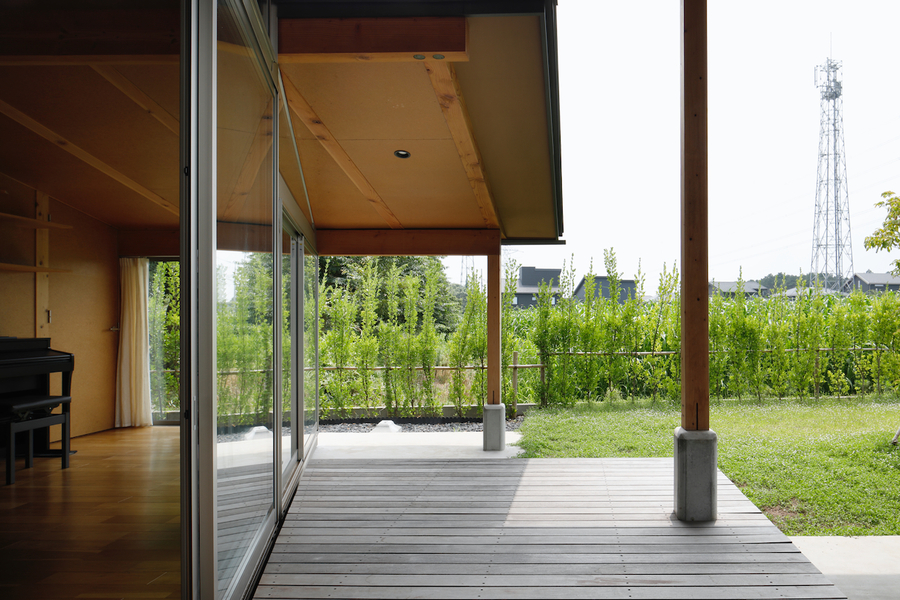
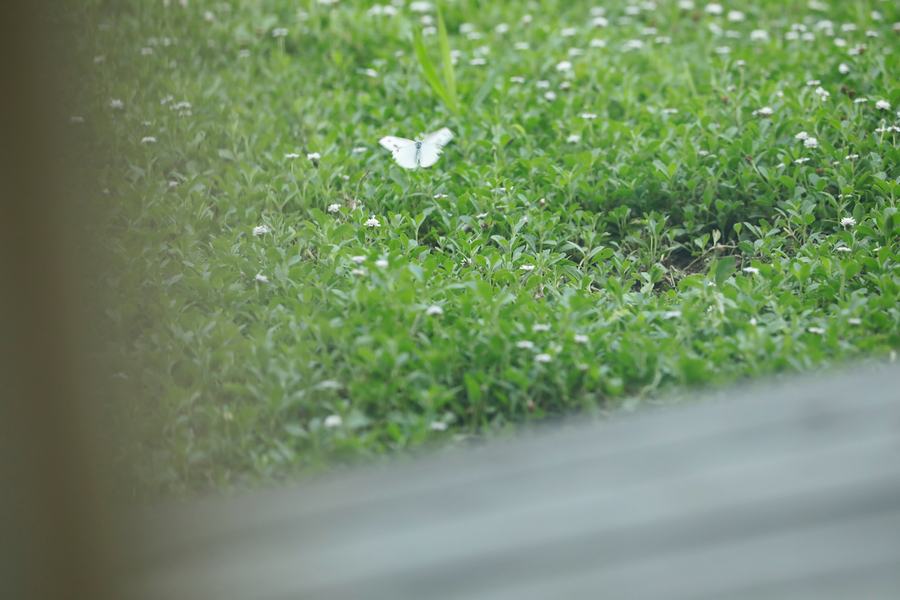
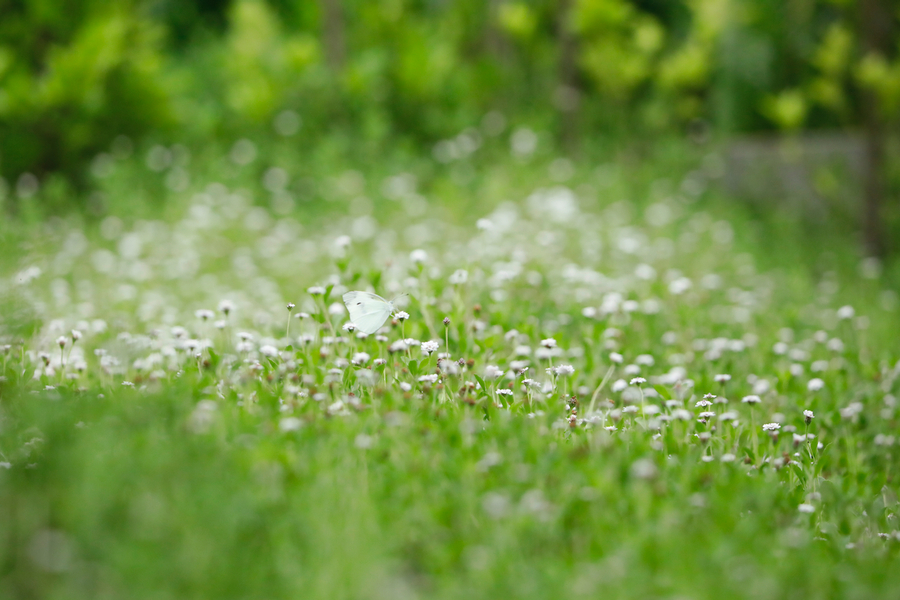
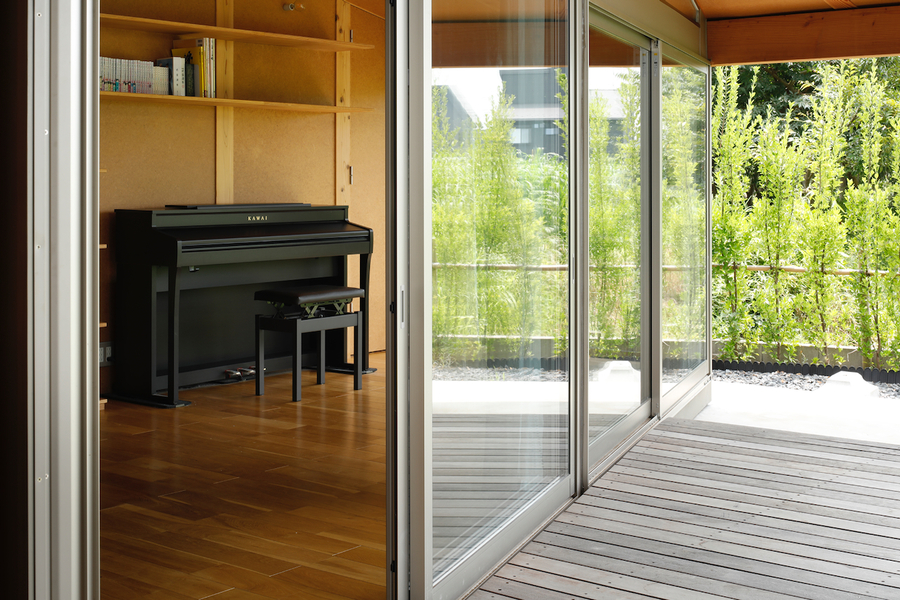
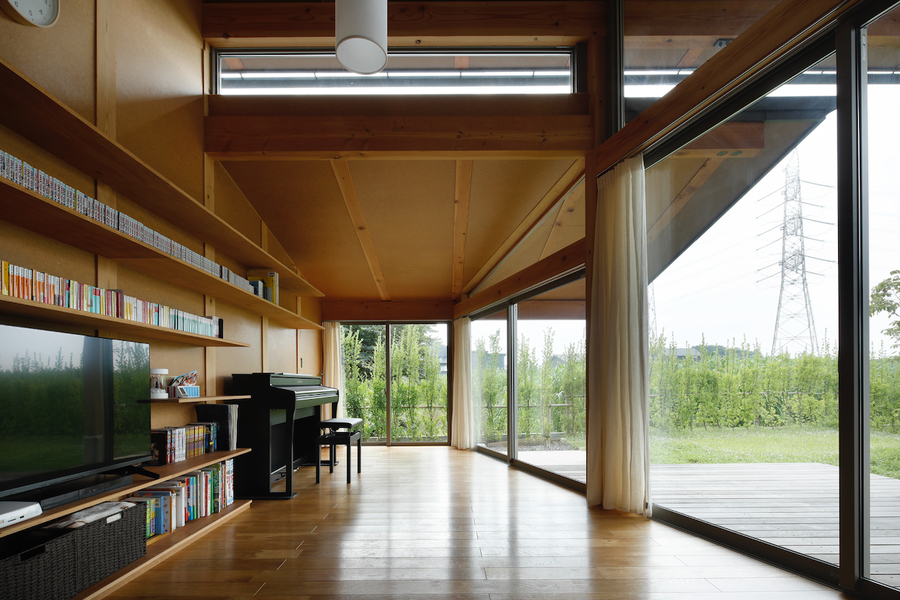
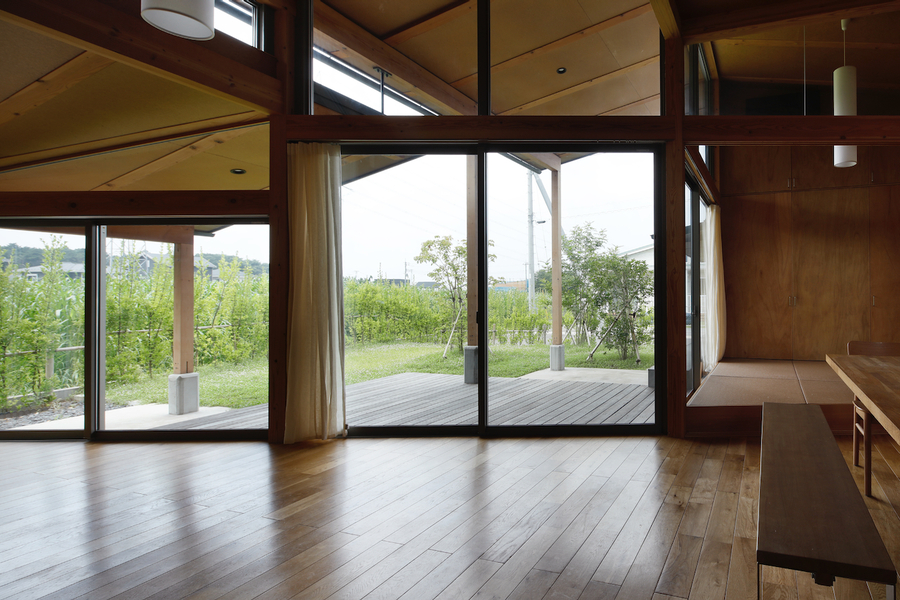
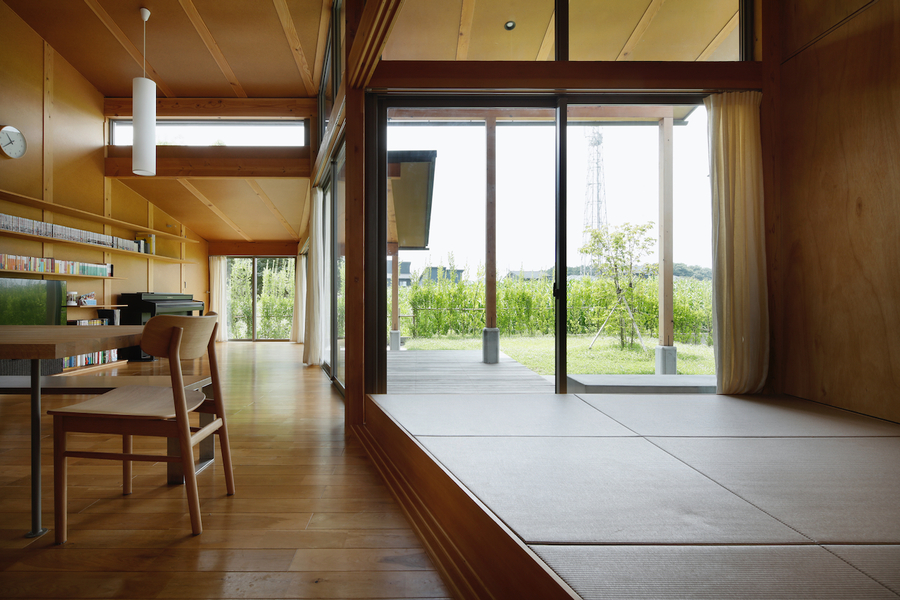
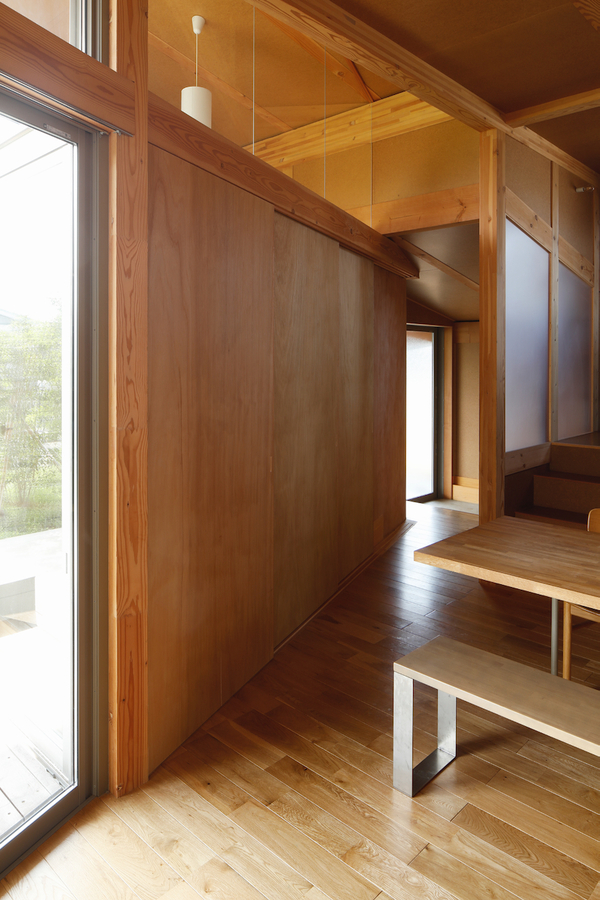

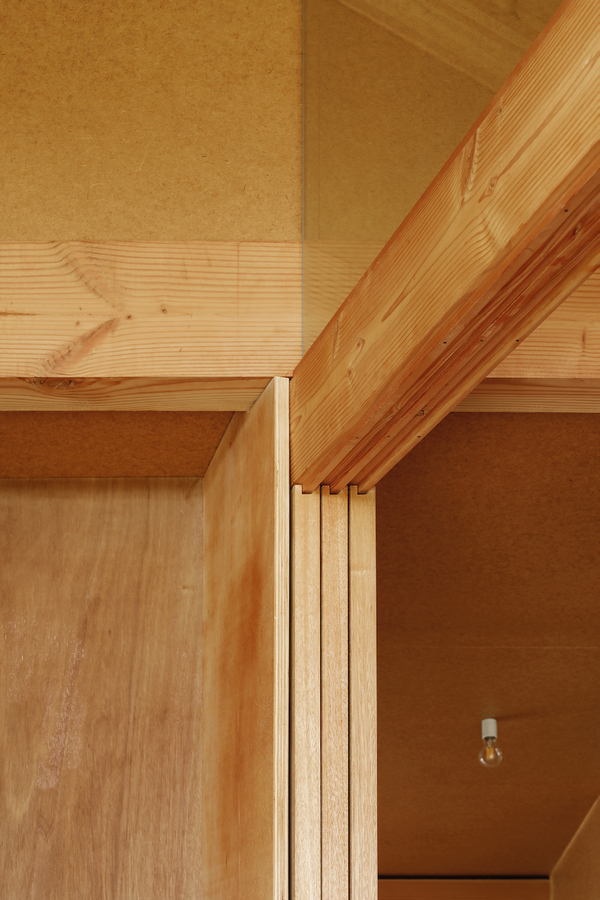
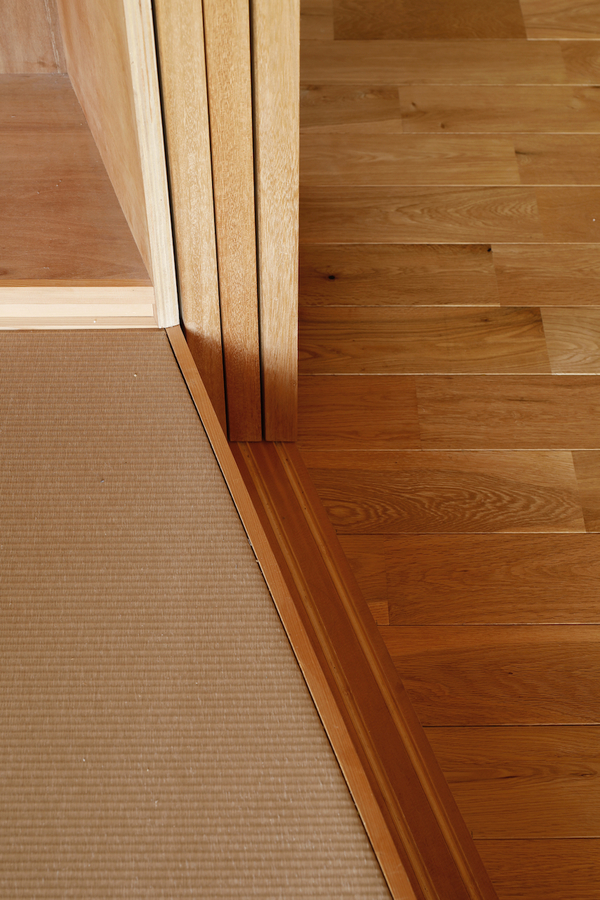

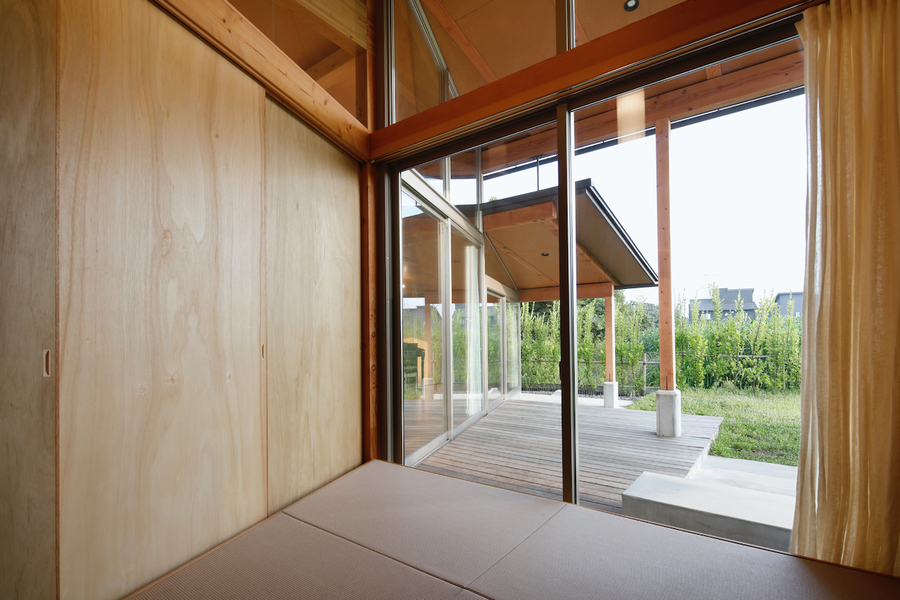
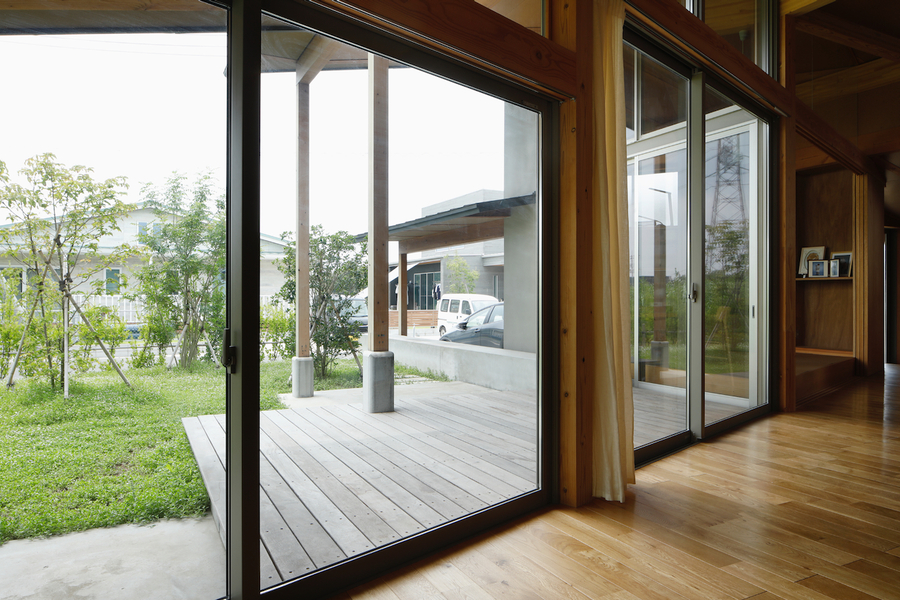

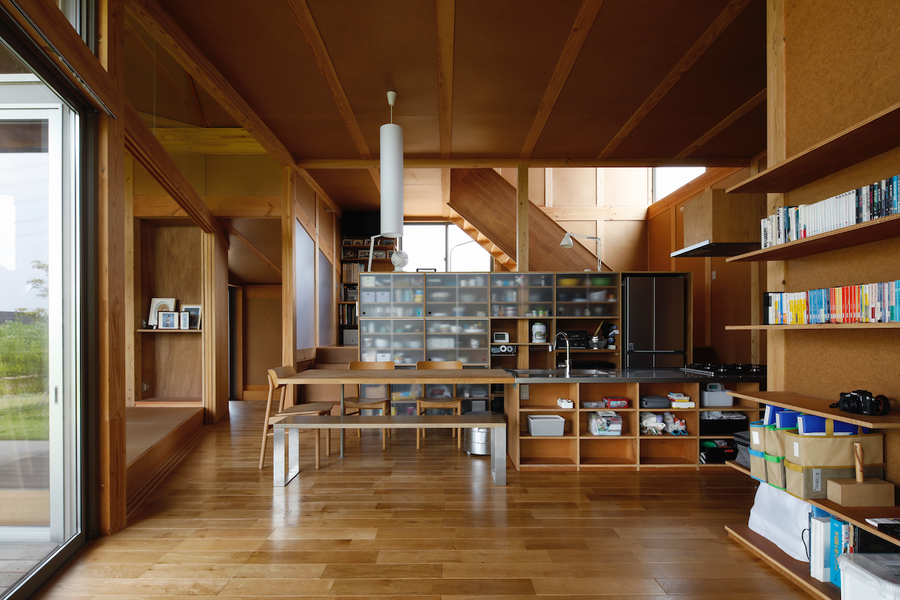
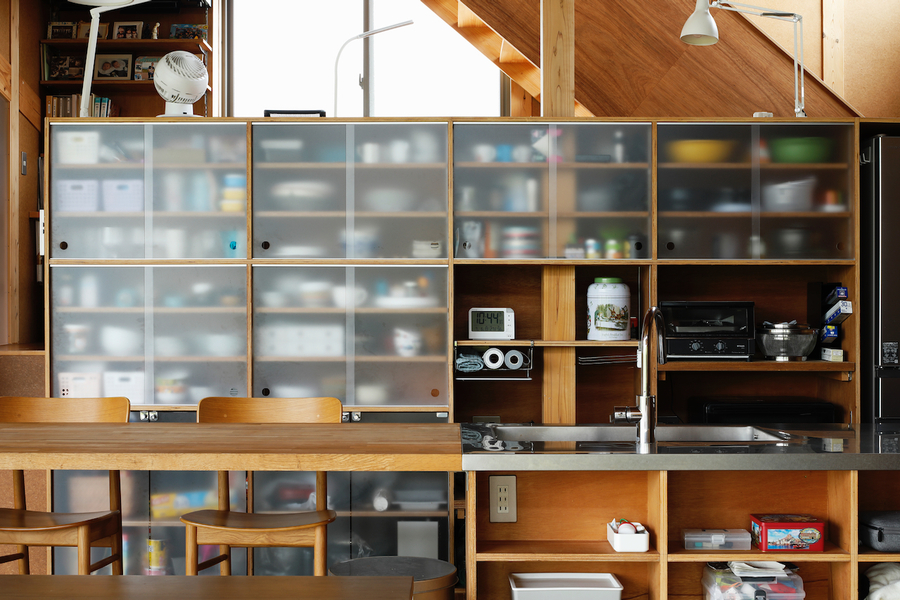

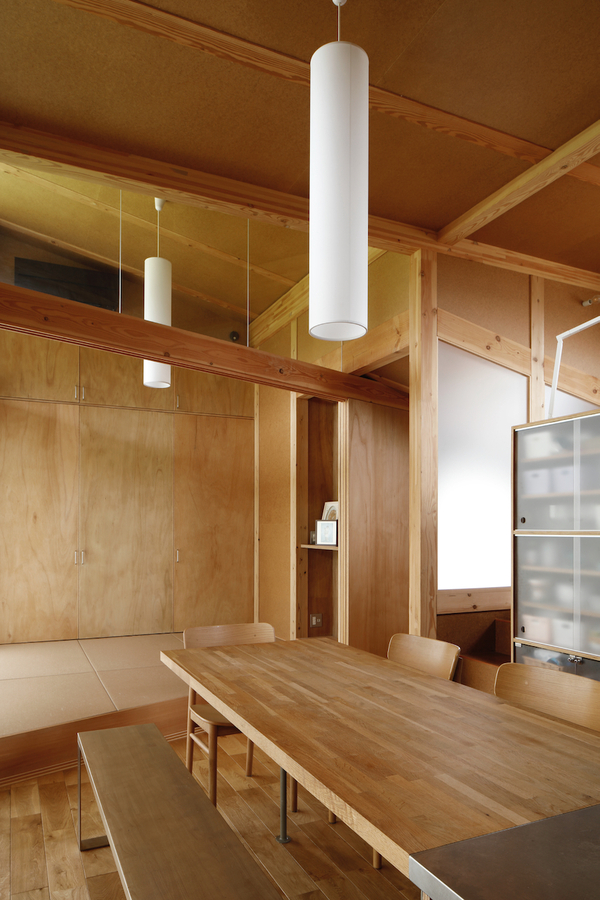

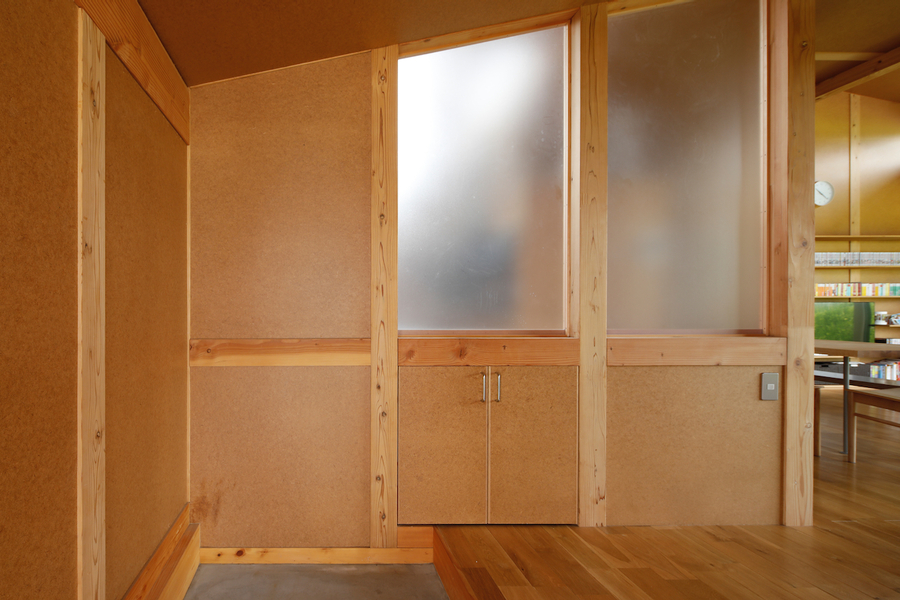

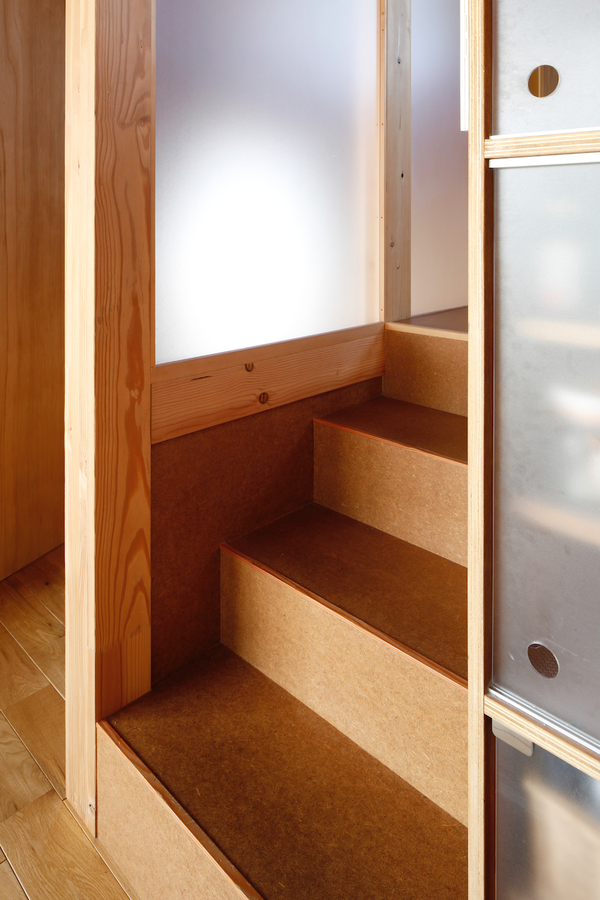
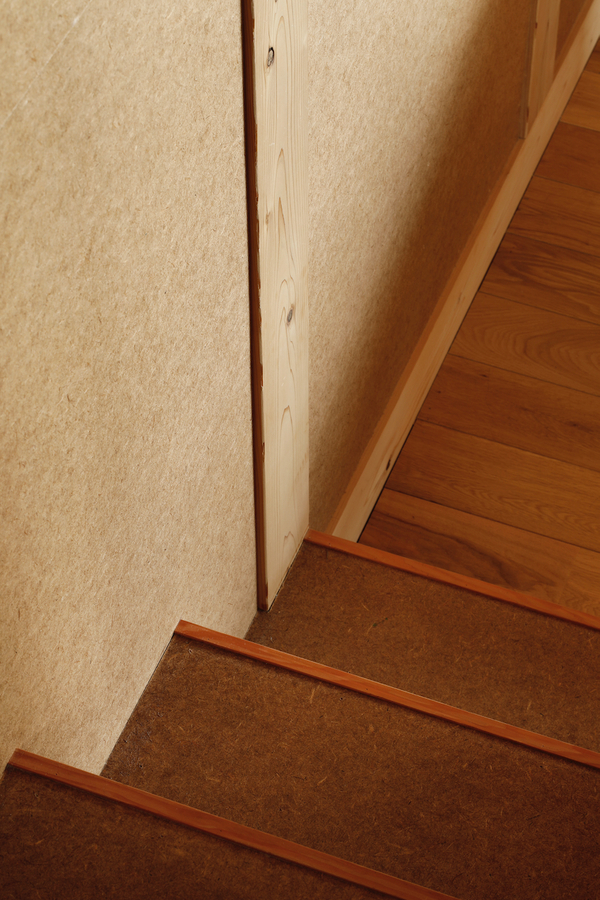
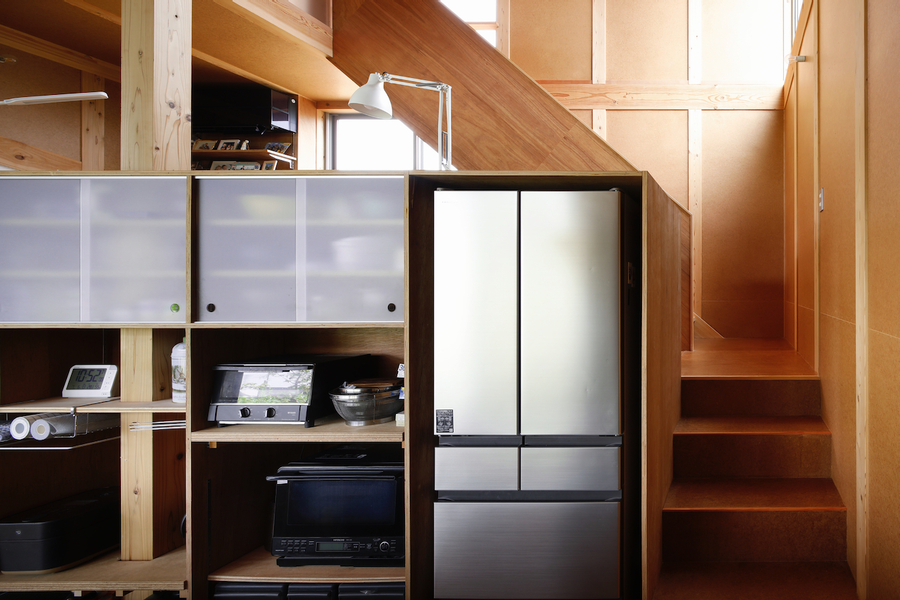
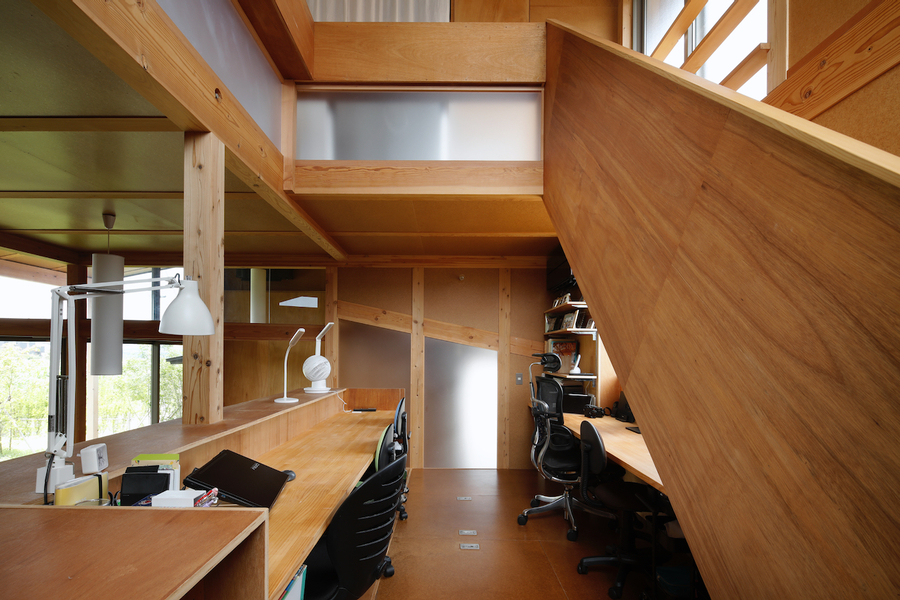
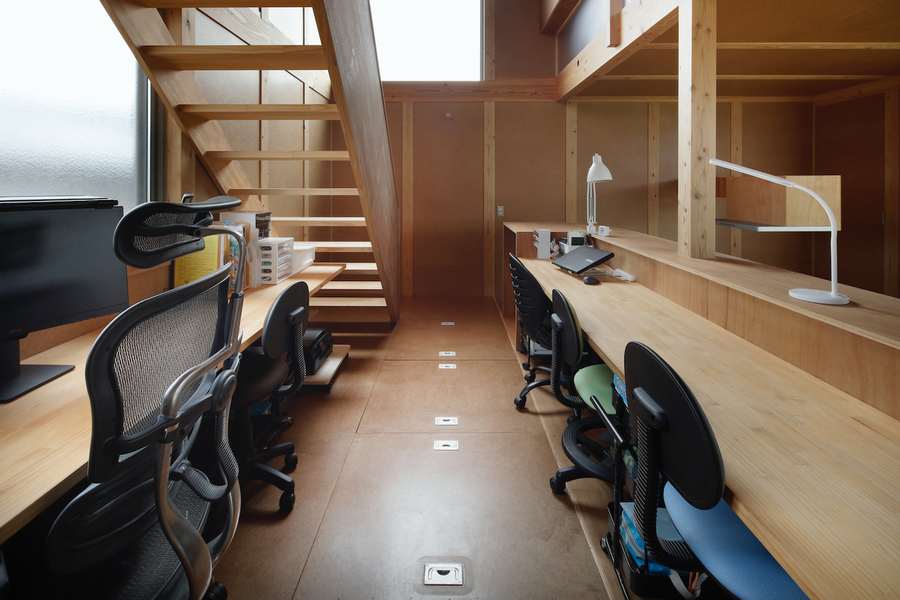
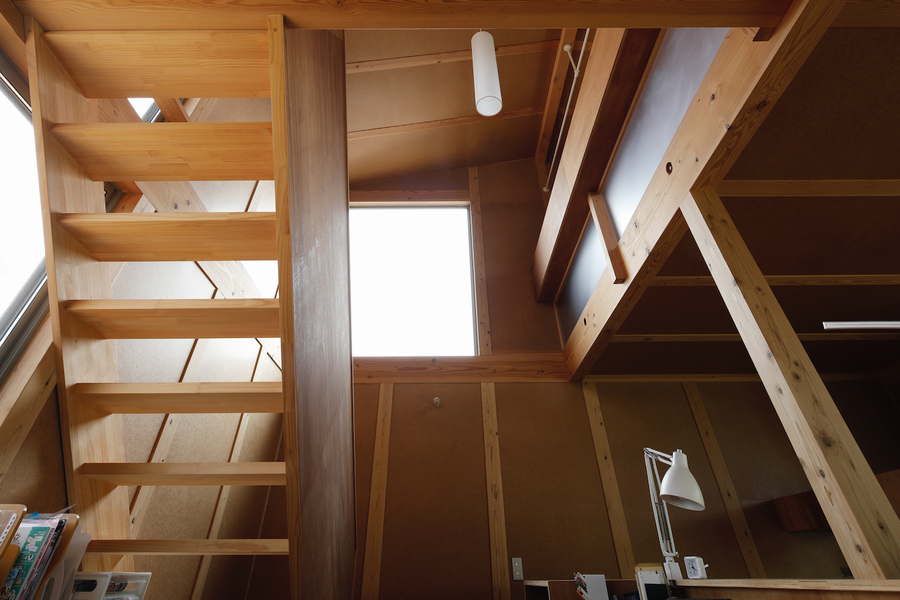
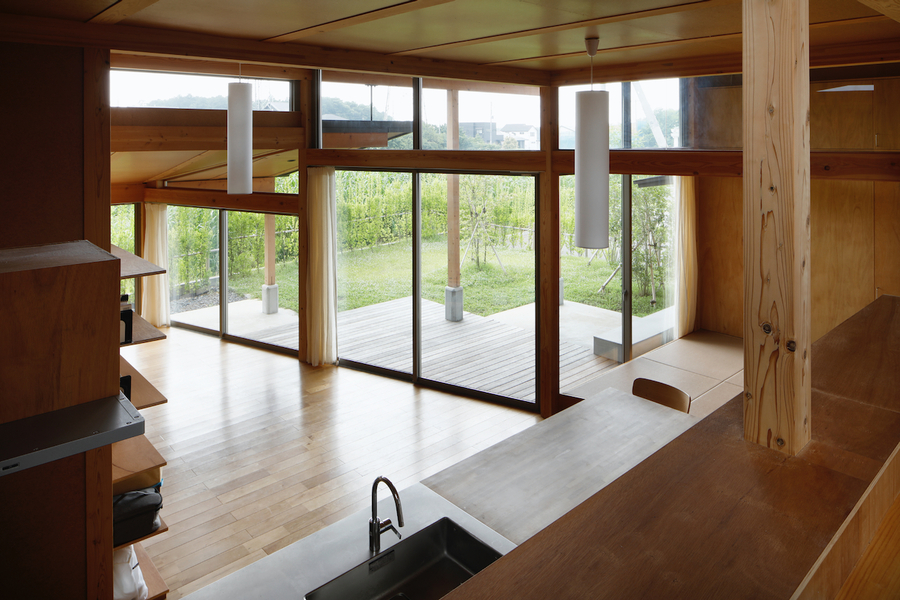
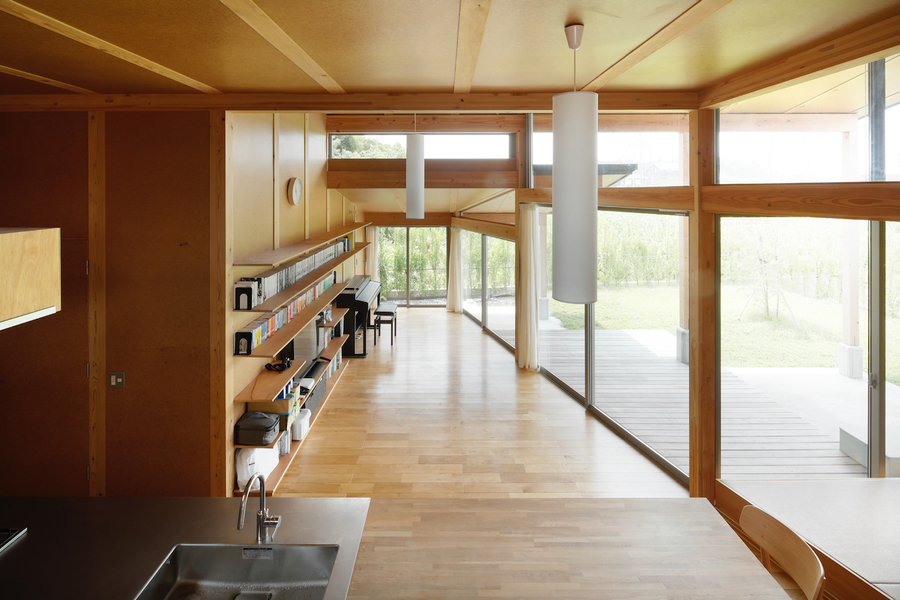


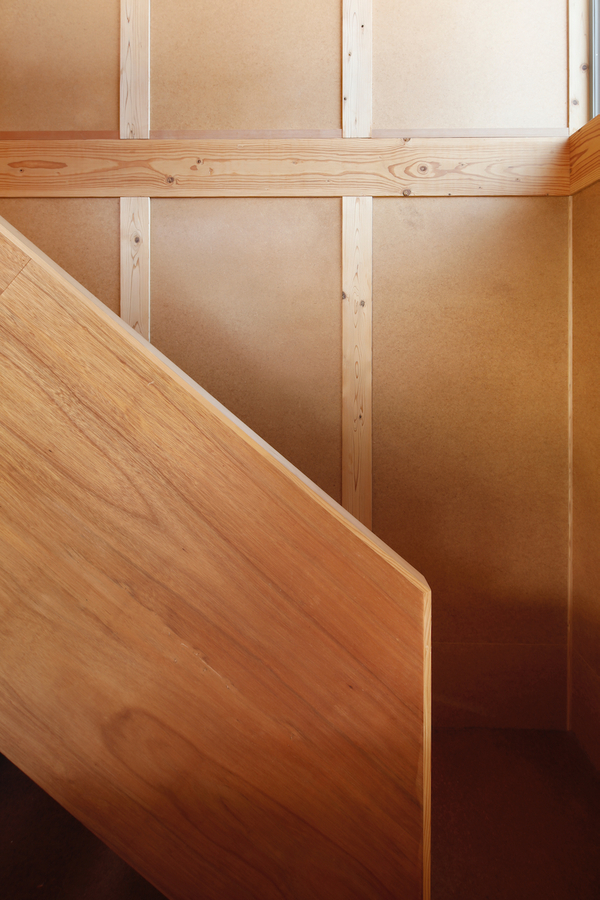
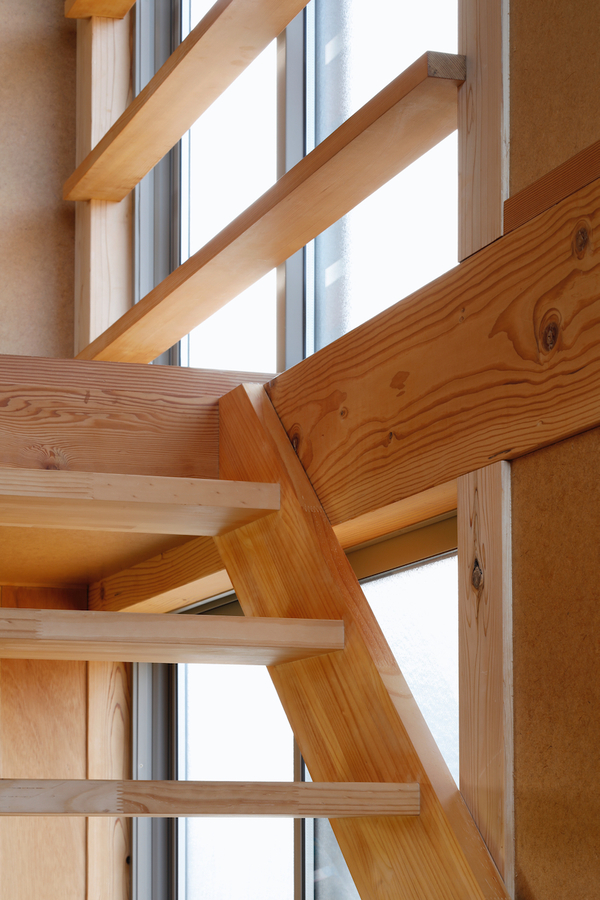
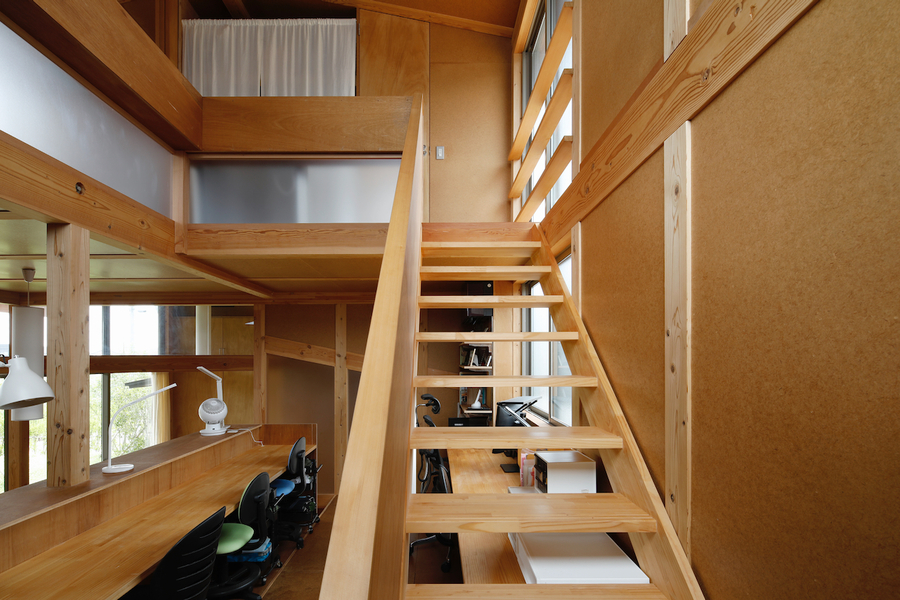
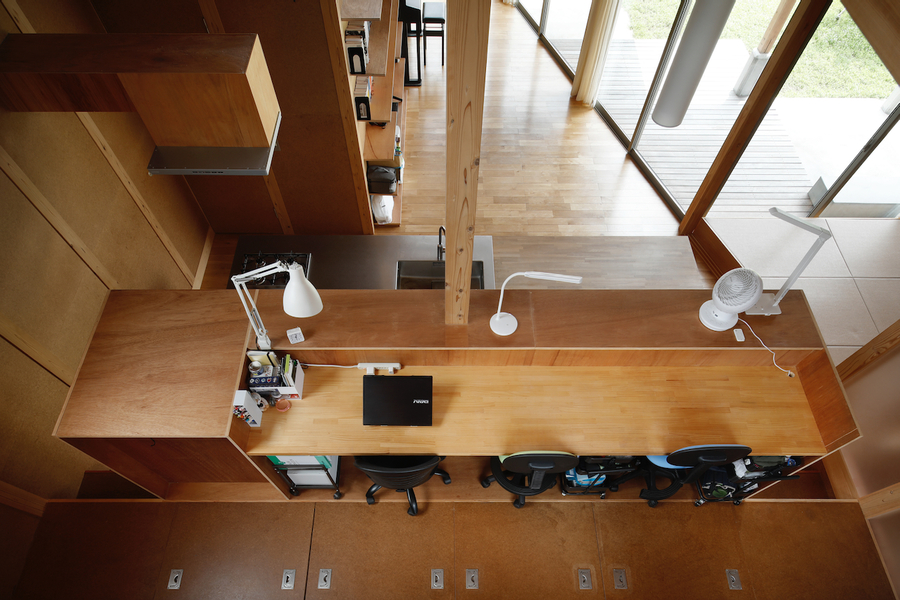
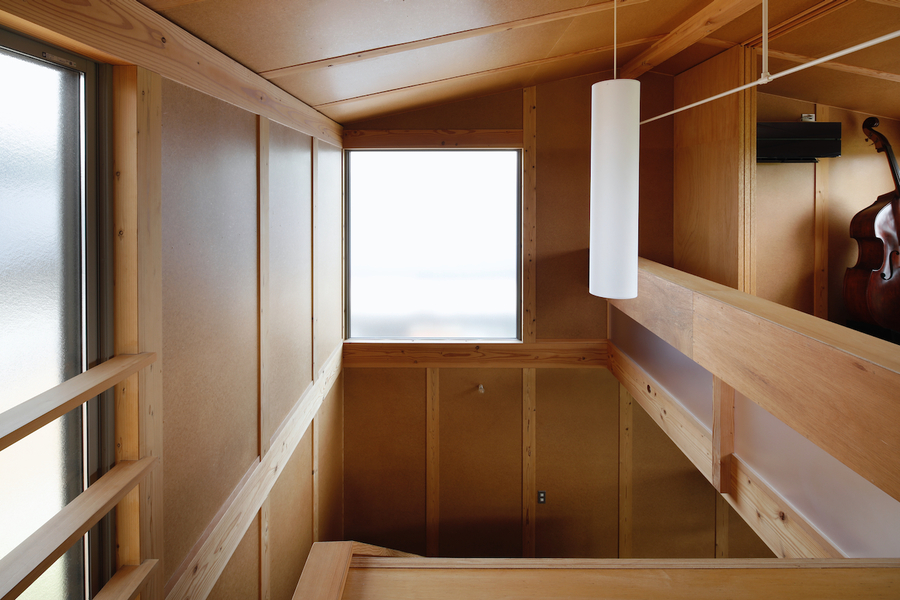
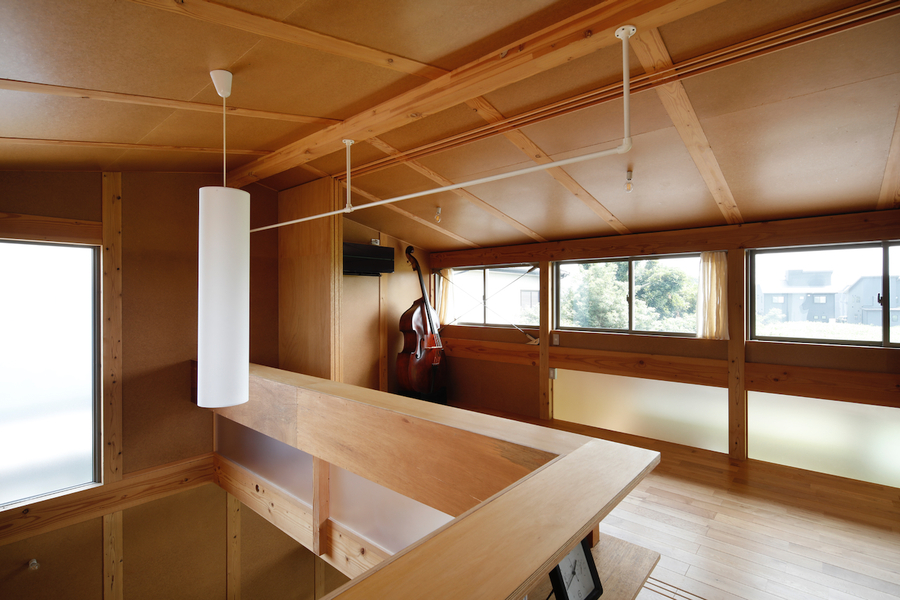
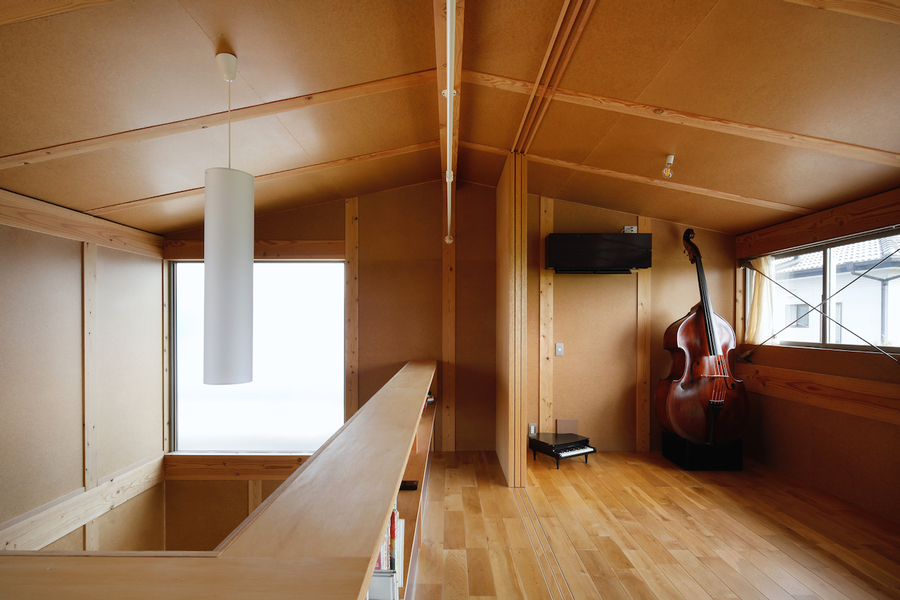
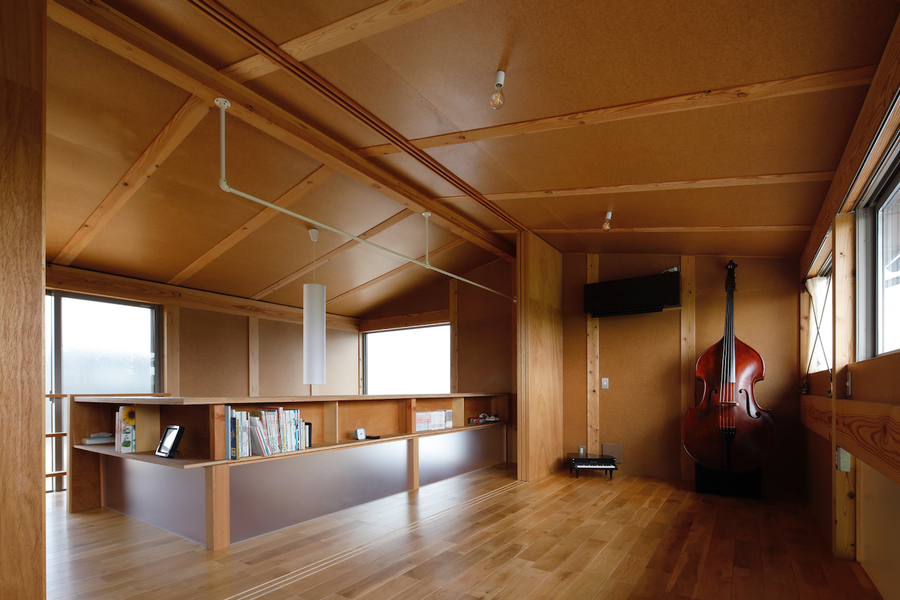
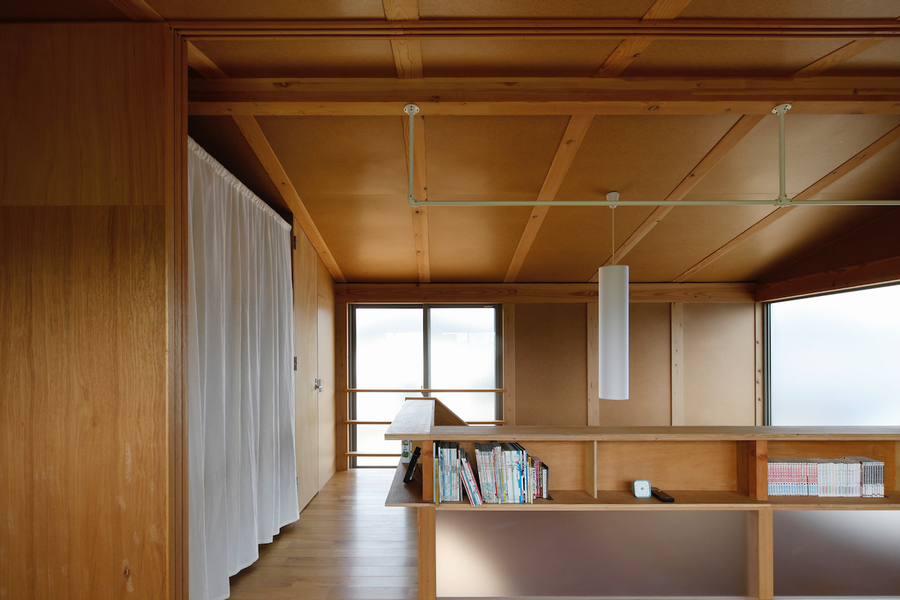

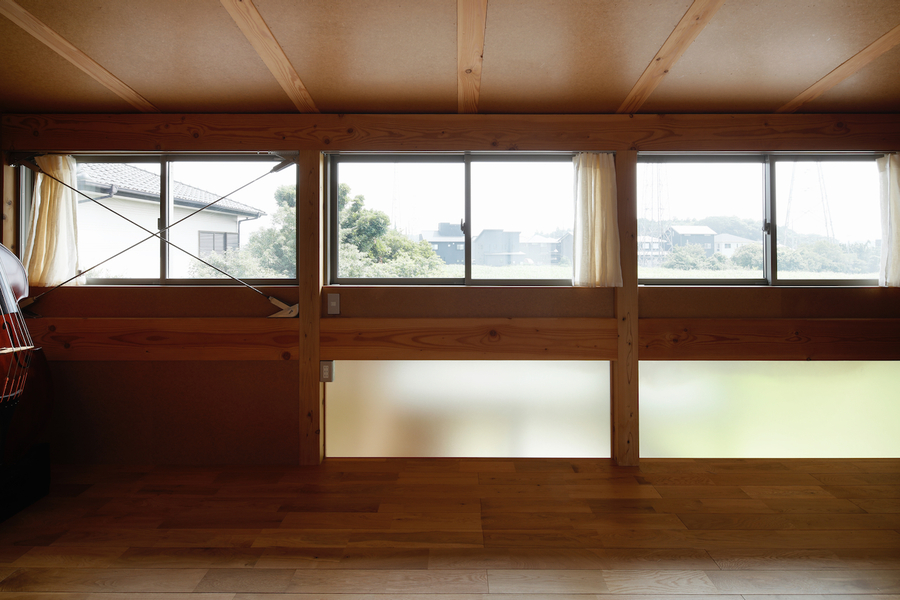
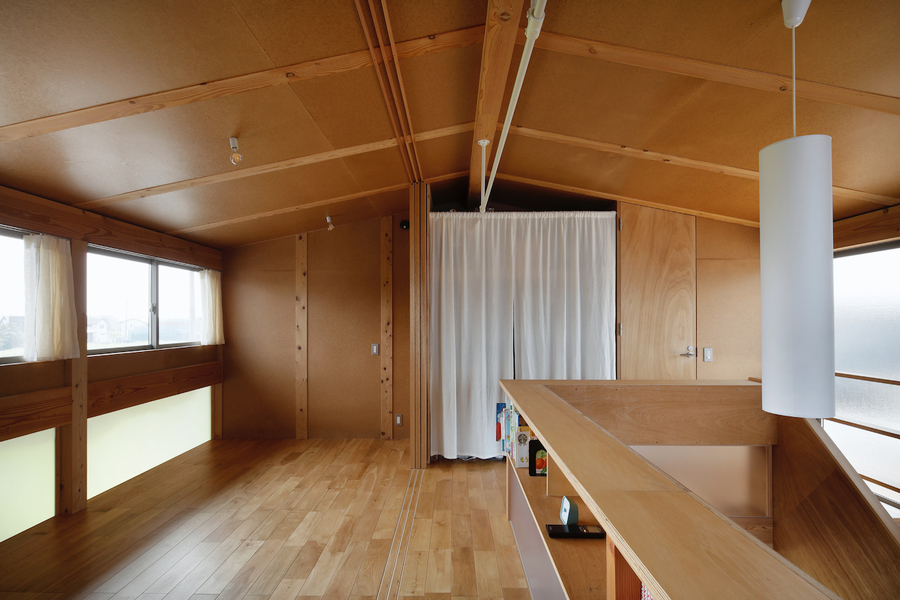

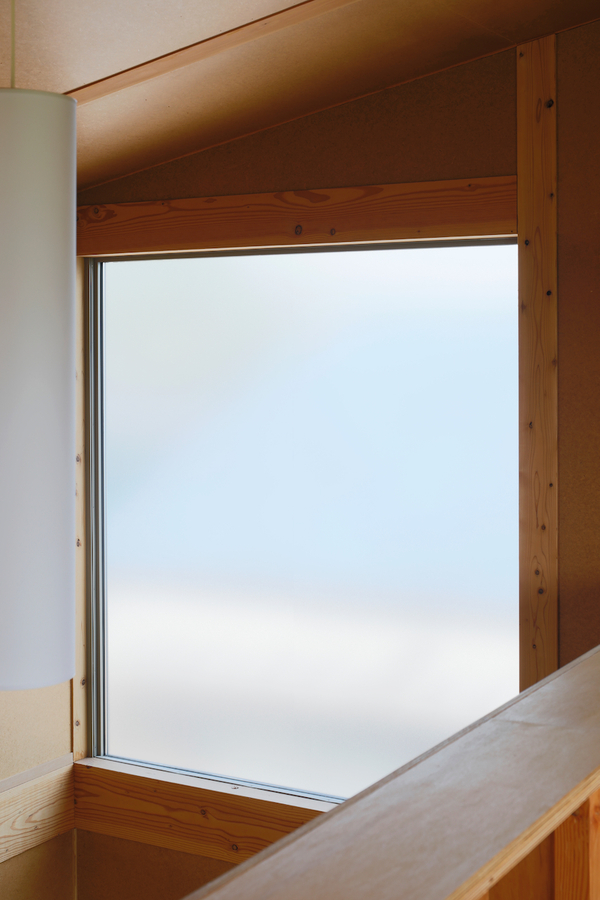


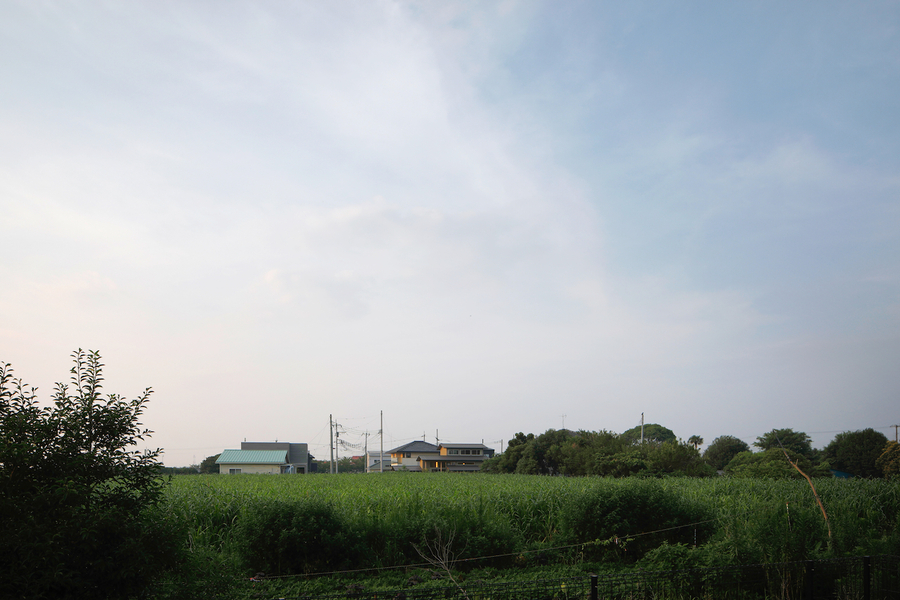
環境
不確かな環境があった。
1997年の東京湾アクアライン開通以来、袖ケ浦は東京都心まで1時間で繋がる首都圏となった。1968年に線引きされた市街化調整区域は、住宅需要に圧されて少しづつ宅地開発が許可されていて、畑や藪と住宅地がせめぎ合う前線に敷地がある。お施主さんが土地を入手したのは藪が切り開かれて宅地造成されている途中の2022年だった。設計をしている間に造成が終わって真新しい宅地が姿を見せ、ポツポツと住宅が建ち始めた。
特徴を求めて敷地のまわりを観察する。南には畑、西には道路。畑の向こうには藪と鉄塔と開発宅地が見える。西の道路は十数区画の開発宅地の行き止まりで、建ちつつある住宅には様々な立面が張り付いている。宅地の区画は200㎡以上で、塀はなく、隣棟間隔が広い。隣の市街化区域には同じような開発宅地が多い。この辺りは農家住宅・畑・藪が多くあって、いずれも囲いは無く、見た目には境界が分からない。開発と未開発が混ざっている感じと、起伏のある地平が広がっている感じがある。
ところで、歴史の無い宅地に寄りすがって設計するのには不安がある。一方で地歴を感じる畑の広がりは爽快である。ところがその畑もいつか開発されるかもしれない。この敷地を取り巻く文脈は安定しておらず、かといって設計できないほど不安定でもなく、準安定状態といえよう。しかしここには暗い感じは無く、むしろ自由と軽やかさの源泉のように思えた。
庭
不確かな環境において住む手がかりとなる庭をつくる。
十分広い敷地に対して建物を計画すると、半分くらいは庭になる。市街化調整区域にある南の畑はいつ宅地開発されるか分からないが、それでも畑と庭は連続すべき。西の道路の向かいにはどんな住宅が建つか分からないが、隣家は一定のセットバックをするだろうし、道路は行き止まりなので静かな空地なので、道路と庭は連続すべき。そのような憶測をもとに、庭は南西にセットする。
周辺環境を信頼して連続と開放を求めれば、周辺環境が変化したときに手詰まりとなる。一方で周辺環境に不信を抱いて敷地内に自閉するのではこの地域の良さを享受できない。変化するかもしれない周辺環境にどっちつかずの態度で接するのが適当と考えて、畑と道路のどちらにも顔を向けられる庭の位置にした。たとえ畑が宅地になったとしても、あるいは道路の向かいに予想外の家が建ったとしても、それなりの住環境を保てるだろう。
間取り
環境と庭を手がかりに間取りをつくる。
環境と庭に対して一方向の開放としては長年の居住で飽きてしまうし、周辺環境が変化したときに手詰まりとなるので、庭と建物の境界を雁行させたり辺を斜行させる。室内に複数の方向への開放、手前と奥、中心と周辺の差ができるように変形を加えていく。周辺環境と庭の都合で外形が定まってくる。
このあたりで木造の制約を意識し始めている。我慢が少ない生活空間にするには2.7mスパンあれば足りる。一方で、材積が抑えられた秩序のある架構を目指すとなると、桁と棟を2.7m間隔に置き、その平行線上に柱を置くのが良さそうだと勘づく。外形の都合と生活の都合と木造架構の都合が平衡して間取りが決まる。外形と生活と木造架構が互いに無理を強いていない状態を、一旦の平衡状態とする。
屋根
環境と庭と間取りに、構えと空間を与える屋根を架ける。
不確かな環境に対して確かな奥をつくること、規範のない宅地に構えをつくること、当面は広がりを期待したい畑の地平を受け入れること、室内から様々に外が見えて光が得られることを条件と決めて、道路に妻面・畑に平面とする1群4枚の2寸勾配屋根を架ける。屋根は室内の外形から大きく張り出して、庭と車停めをも覆う。屋根が環境と庭と間取りを統合する。
屋根は複数枚に分かれていて環境の開放性に応えるとともに、群の造形によって構えと覆いをなしていて不確かな環境に応える。小さくて大きく、単純であって複雑であり、離散的であって求心的であり、素朴であって立派である。対の意味や、矛盾や、不確かさを屋根が調停する。
床、家具
屋根の下に人が住む場所をつくる。
屋根の下はまだ不確かでスケールが大きくて人が住むには心もとなく、経験される空間が一様で一意的である。そこで1階の床に凹凸させて2階の床につなぎ、気分が途切れないように地平とすべての床を連続させる。床の段差は空間に複数の向きを与えるとともに、屋根の勾配と合わさって空間が流動する。
段差に応えるようにキッチンとテーブルのセット・デスク・階段を設え、住む人の姿勢と向きをアフォードする。室内が機能を備えて、人の住める場所がようやく現れる。
印象の仕立て
場所の印象を仕立てる。
不確かな環境や目まぐるしい生活に対する確固たる印象と、住み続けるための繊細な印象をもたらす必要があり、架構によってインテリアを仕立てる。見付120mm、見込10mm程度の軸組が現れるように、繊維板をはめ込む。2730mmピッチで強い印象の構造材が現れるとともに、910mmピッチで構造とも化粧とも見て取れる木材が現れる。一本一本の木材も一枚一枚の繊維板も、ともに自律的な形を見せるようにして、群が覆いをなす場所とする。
基調となるスケールを架構でつくった上で、その半分の400mmほどのモジュールで家具を仕立てて高密さをもたせたり、3~4mほどの窓・柱・天板・手摺壁でもって壮大さをもたせたり、スケールとプロポーションで印象をつくる。
環境の見立ての更新
不確かな環境から始めて、仮定を積み上げて、平衡に気をつけながら、空間を現実につくると、現実が少し更新されたように感じる。目の前にある畑は奇跡的に存在しているように見えるし、同じ宅地にある木造住宅は開花していない可能性が潜在しているように見える。環境から始めて場所をつくると環境の見立てが更新されるのである。
永く持続した場所であれば、都市が建築をつくり、建築が都市をつくり、街並みが生まれて、文化が生まれるだろう。それはオーセンティックで強度のある空間の編まれ方であるが、世界に現存する環境は不確かであることの方が多い。不確かさを前提とした空間の作り方を個々に繰り返すことで、世界を良い方向に前進させられるのではないだろうか。本住宅はそうした実践の一粒である。
設計監理 IN STUDIO(小笹泉、奥村直子)
構造設計監理 MOF(諸藤仁美)
施工 末吉林業
所在地 千葉県袖ケ浦市
建築面積 109.30m2
延床面積 92.17m2
階数 地上2階
構造 在来木造
設計期間 2022.2-2022.12
施工期間 2023.1-2023.7
写真 来田猛
Environment
There was an uncertain environment.
Since the opening of the Tokyo Bay Aqualine in 1997, Sodegaura has become a metropolitan area that is connected to central Tokyo in one hour. the urbanization control area, which was delineated in 1968, has been allowed to develop residential land little by little due to housing demand, and the site is located on the front line where fields, bushes and residential areas are in conflict with each other. The client acquired the land in 2022, when the bushes were being cleared and the land was being developed into residential land. While we were designing the house, the land development was finished, a brand new housing site appeared, and houses began to be built one by one.
We observed the surroundings of the site in search of features. To the south is a field and to the west is a road. Beyond the field, bushes, a steel tower, and a housing development site can be seen. The road to the west is a dead end for more than a dozen lots of developed housing, and various elevations are attached to the houses that are being built. The housing lots are over 200 m2 in size, with no walls and wide spacing between adjacent buildings. There are many similar developed housing lots in the adjacent urbanized area. There are many farm houses, fields, and bushes in this area, none of which are enclosed, and the boundaries are not visually discernible. There is a sense of a mixture of developed and undeveloped areas and an undulating horizon.
By the way, I am uneasy about designing a house leaning against a housing site with no history. On the other hand, it is refreshing to see an expanse of fields with a sense of geological history. On the other hand, the expanse of fields with a sense of geological history is invigorating. The context surrounding the site is not stable, but it is not so unstable that it is impossible to design, and can be said to be in a semi-stable state. However, there is no sense of gloom here; rather, it seems to be a source of freedom and lightness.
Garden
The garden is a clue to living in an uncertain environment.
When a building is planned on a large enough site, about half of it will be a garden. The field to the south in the urbanization control area may be developed into residential land at any time, but even so, the field and the garden should be contiguous. We do not know what houses will be built across the road to the west, but the road and yard should be contiguous because the neighbor's house will have a certain setback and the road is a dead end, so it is a quiet vacant lot. Based on that speculation, the yard should be set to the southwest.
If we trust the surrounding environment and seek continuity and openness, we will be stuck when the surrounding environment changes. On the other hand, if we are distrustful of the surrounding environment and keep ourselves inside the site, we will not be able to enjoy the good qualities of this area. We thought it would be appropriate to have a neutral attitude toward the changing surrounding environment, so the garden was positioned so that it could face both the field and the road. Even if the field were to be turned into residential land or an unexpected house were to be built across the street, the house would still be able to maintain a reasonable living environment.
Floor Plan
The environment and the garden were used as clues to create the floor plan.
If the house is open to the environment and garden in one direction, it will become boring after many years of living in it, and it will become a dead end when the surrounding environment changes. Therefore, we will add transformations so that the interior can be open to multiple directions, and the difference between the front and the back, and between the center and the periphery can be created. The external form is determined by the surrounding environment and the convenience of the garden.
At this point, we are beginning to be aware of the restrictions of the wooden structure. A span of 2.7m is sufficient to create a living space with little patience. On the other hand, if the goal is to create an orderly structure with a limited amount of lumber, I realized that it would be better to place girders and ridges at intervals of 2.7m and to place columns on the parallel lines between them. The floor plan is determined by the equilibrium between the convenience of the external form, the convenience of living, and the convenience of the wooden structure. The equilibrium state is defined as a state in which the external form, the living space, and the wooden structure do not force each other to do anything.
Roof
The roof is to give structure and space to the environment, the garden, and the floor plan.
The roof is a group of four 2" pitched roofs, gabled to the road and flat to the field, to create a certain depth to an uncertain environment, to create a structure on an unregulated site, to accept the horizon of a field that is expected to expand for the time being, and to allow various views of the outside from the interior and to obtain light. The roof extends well beyond the exterior of the interior, covering the garden and the parking area. The roof integrates the environment, the garden, and the floor plan.
The roof is divided into several pieces to respond to the openness of the environment, while at the same time responding to the uncertainty of the environment by forming a group structure and covering it. It is small and large, simple and complex, discrete and centripetal, simple and magnificent. The roof mediates between pairs of meanings, contradictions, and uncertainties.
Floors, furniture
The roof creates a place for people to live under.
Under the roof is still too uncertain and large in scale for human habitation, and the space experienced is uniform and unique. Therefore, the floor of the first floor is uneven and connected to the floor of the second floor, making the ground level and all the floors continuous so that the mood is not interrupted. The steps in the floor give the space multiple orientations, and combined with the slope of the roof, the space becomes fluid.
The kitchen, table set, desk, and staircase are installed to respond to the steps, affording the posture and orientation of the inhabitants. With the interior equipped with functionality, a place for human habitation finally emerges.
Tailoring the impression
Tailor the impression of the place.
It is necessary to create a firm impression of the uncertain environment and fast-paced life, as well as a subtle impression for continued living. Fiberboards are inserted so that a shaft structure of 120mm in appearance and 10mm in appearance appears. 2730mm pitch structural timbers with a strong impression appear, and 910mm pitch timbers, which can be seen as both structural and decorative, appear. Both the individual timbers and the individual fiberboards are made to show autonomous forms, making the group a place of covering.
After creating the basic scale of the structure, the impression is created through scale and proportion, such as by tailoring the furniture with modules of 400mm, half the size, to create a high density, or by creating a grandeur with windows, columns, tops, and balustrade walls of 3~4m in length.
Updating the environment's appearance
Starting with an uncertain environment, building up assumptions, and creating a space in reality while paying attention to equilibrium, one feels as if reality has been slightly renewed. The field in front of me seems to miraculously exist, and the wooden house on the same housing site seems to have latent potential that has not yet blossomed. When we create a place by starting with the environment, we renew our view of the environment.
In a long-lasting place, the city will create architecture, architecture will create the city, streetscapes will emerge, and culture will emerge. This is an authentic and strong way of weaving space, but the existing environment in the world is more often than not uncertain. By repeating the process of creating space based on uncertainty, we can move the world forward in a positive direction. This residence is a grain of such a practice.
Design & Supervision : IN STUDIO (Izumi Kosasa, Naoko Okumura)
Structural Design & Supervision :MOF (Hitomi Morofuji)
Construction : Sueyoshi Forestry
Location : Sodegaura City, Chiba
Building area : 109.30m2
Total floor area : 92.17m2
Number of floors : 2 floors above ground
Structure : Conventional wood
Design period : 2022.2-2022.12
Construction period : 2023.1-2023.7
Photo : Takeru Koroda